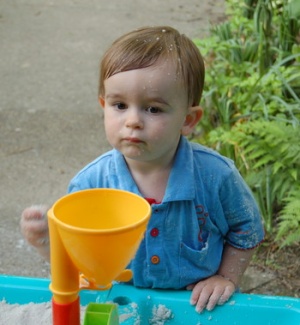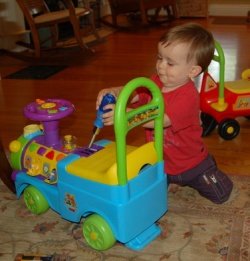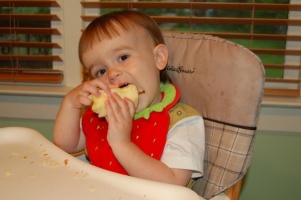We might just have a Southpaw on our hands. Matt and I have noticed for several months that Simon prefers to throw with his left hand. In fact, if we hand him a ball in his right hand or he catches a ball in his right hand, he will usually transfer it to his left before throwing it. He also holds a spoon in his left hand and better manipulates toys in his left hand. My mom noticed just last week that he can get coins in his piggy bank easily using his left hand, but can’t accomplish the same task using his right hand alone.
This may carry over to footedness as well. I’ve noticed that when Simon goes to “walk” up or down stairs (when he no longer needs help, I’ll drop the quote marks), he raises his left foot first. I haven’t consistently done all the usual tests or done some of the tests at all. We haven’t, say, seen which eye he stares through a tube with.
I assumed pretty much until Friday that this was just a stage he was going through. After all, at a year he did everything with his right hand. But Amy informed me at our session on Friday that handedness can become evident by around 18 months, and that Simon’s nearly uniform preference for his left side may well indicate that he’s left handed. In other words, while it would not be surprising if he switched hand dominance in the next few months or even years, it’s more likely that he’s a lefty.
I’m torn on this. On the con side, there’s the fact that while we no longer “beat” left-handedness out of people or consider it a sign of evilness or sorcery, it’s still easier to be a righty in this world. Whether you are sitting at a dinner party, learning to write, or using shared office and school equipment, it’s inconvenient to be left-handed.
On the pro side, it’s one more thing for me to have fun researching, and if it sticks around, it might make Simon a more formidable opponent on the tennis court. Or in the boxing ring, but I can’t bring myself to even imagine that possibility.
And why might Simon be a lefty? I don’t think anyone really knows, but every theory out there has some support in our situation.
- Maternal age: Left-handed children are much more common among older mothers. A 40-year old woman is 128% more likely to give birth to a left-handed baby than a woman in her twenties. I was nearly 37 when I had Simon. This may be because of an increased likelihood of having a difficult pregnancy or arduous delivery. It could also be because older moms are more likely to have varying hormone levels during pregnancy, and left-handedness may be triggered by testosterone.
- Genetics: Left-handedness runs in families. My father (born, notably, to an older mother himself) is left handed, as was my maternal great-grandfather. I’m not sure about the Whitworths, but I seem to recall a mention of lefties in their ranks, too.
- Gender: Males are much more likely to be left-handed than females. Simon is a boy all right. His current obsession with trucks, busses, and anything loud with an engine is making that quite clear each day.
- Birth order: Lefties are much more likely to be first-born or sixth born or later. Hormone fluctuations are more common in first and late pregnancies than middle ones. Simon is my first born.
- Brain damage: Let’s hope not. But there is also a correlation between brain trauma suffered in utero or during a difficult birth and left-handedness. Similarly, a disproportionate number of people with mental retardation are left handed. Simon D-celled a lot when he was being born and gulped down amniotic fluid during delivery, but I don’t think any of that amounts to brain damage. I’m going to pretend I didn’t find that tid-bit! Some studies list trauma such as difficulty breathing at birth as a cause of left-handedness and a sign that there are “pathological” left-handed people who are separate from “genetic”ones. This does make me wonder if Simon’s early need for oxygen might constitute mild damage.
Other than that last point, it’s all good. In fact, at least one professor who researches the topic argues that left-handed people historically accomplish more than their right-handed counterparts and that their brains are structured differently in a way that widens their range of abilities.
Having a little genius on my hands sounds swell and all, but there is a significant catch. IF Simon inherits my handwriting abilities; and IF we adjust my handwriting for being male and left-handed; THEN we have Ivan Goldstein’s handwriting on our hands, which may well be the worst handwriting recorded in history. (Mine is a close second; and is equally bad in English print, English cursive, Hebrew, and cuneiform. I have yet to find a written language in which my hand is legible.) Therefore, any left-handed-related increase in Simon’s academic abilities will likely be offset by his teachers’ total inability to decipher his scrawl.
Then again, he may start using his right hand tomorrow!



